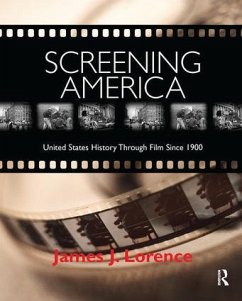- Gebundenes Buch
- Merkliste
- Auf die Merkliste
- Bewerten Bewerten
- Teilen
- Produkt teilen
- Produkterinnerung
- Produkterinnerung
By combining the study of films with the text-based primary sources, this book gives students guidance in studying, interpreting, and understanding the motion picture's significance as a primary source in investigating US History.
Andere Kunden interessierten sich auch für
![The Origins of Leftwing Cinema in China, 1932-37 The Origins of Leftwing Cinema in China, 1932-37]() Vivian ShenThe Origins of Leftwing Cinema in China, 1932-37187,99 €
Vivian ShenThe Origins of Leftwing Cinema in China, 1932-37187,99 €![The Politics of Iranian Cinema The Politics of Iranian Cinema]() Saeed Zeydabadi-NejadThe Politics of Iranian Cinema187,99 €
Saeed Zeydabadi-NejadThe Politics of Iranian Cinema187,99 €![Hong Kong Cinema Hong Kong Cinema]() Yingchi ChuHong Kong Cinema181,99 €
Yingchi ChuHong Kong Cinema181,99 €![Hollywood and Anticommunism Hollywood and Anticommunism]() John J GladchukHollywood and Anticommunism180,99 €
John J GladchukHollywood and Anticommunism180,99 €![Making the Best Years of Our Lives: The Hollywood Classic That Inspired a Nation Making the Best Years of Our Lives: The Hollywood Classic That Inspired a Nation]() Alison MacorMaking the Best Years of Our Lives: The Hollywood Classic That Inspired a Nation44,99 €
Alison MacorMaking the Best Years of Our Lives: The Hollywood Classic That Inspired a Nation44,99 €![What Have They Built You to Do? What Have They Built You to Do?]() Matthew Frye JacobsonWhat Have They Built You to Do?16,99 €
Matthew Frye JacobsonWhat Have They Built You to Do?16,99 €![Movie Studios of Culver City Movie Studios of Culver City]() Julie Lugo CerraMovie Studios of Culver City22,99 €
Julie Lugo CerraMovie Studios of Culver City22,99 €-
-
-
By combining the study of films with the text-based primary sources, this book gives students guidance in studying, interpreting, and understanding the motion picture's significance as a primary source in investigating US History.
Hinweis: Dieser Artikel kann nur an eine deutsche Lieferadresse ausgeliefert werden.
Hinweis: Dieser Artikel kann nur an eine deutsche Lieferadresse ausgeliefert werden.
Produktdetails
- Produktdetails
- Verlag: Taylor & Francis
- Seitenzahl: 224
- Erscheinungstermin: 3. Juli 2017
- Englisch
- Gewicht: 570g
- ISBN-13: 9781138425897
- ISBN-10: 1138425893
- Artikelnr.: 48950064
- Herstellerkennzeichnung
- Libri GmbH
- Europaallee 1
- 36244 Bad Hersfeld
- gpsr@libri.de
- Verlag: Taylor & Francis
- Seitenzahl: 224
- Erscheinungstermin: 3. Juli 2017
- Englisch
- Gewicht: 570g
- ISBN-13: 9781138425897
- ISBN-10: 1138425893
- Artikelnr.: 48950064
- Herstellerkennzeichnung
- Libri GmbH
- Europaallee 1
- 36244 Bad Hersfeld
- gpsr@libri.de
Lorence, James
Preface.Introduction: THE ANALYSIS OF PRIMARY SOURCES: AN INTRODUCTORY
COMMENT.I. PROGRESSIVE AMERICA: MILITANT REFORM AND POSTWAR REACTION. 1.
Social Protest: A Corner in Wheat (1909) as Muckraking Film. 2. Cultural
History Through a Cloudy Lens: The Birth of a Nation (1915) and the Racial
Climate of Progressive America. 3. Social Change and Sexual Politics:
Dancing Mothers (1926) and Moral Ambiguity in the Jazz Age. 4. The End of
Romantic War: All Quiet on the Western Front (1930) and Disillusionment in
the Interwar Era II. A NATION UNDER STRESS: FROM THE DEPTHS OF ECONOMIC
DESPAIR TO THE BRINK OF WAR. 5. Making It in Depression America: The
Streets or the Stage as Gold Diggers of 1933 (1933) 6. The Resilient
People: The Grapes of Wrath (1940) Exposes Poverty in the Land of Plenty.
III. A DEMOCRACY OF WAR. 7. Thinking of Intervention: Foreign Correspondent
(1940) and the Winds of War. 8. Government Persuasion: Prelude to War
(1943), The Negro Soldier (1944), and the Issues of the War. 9. Social
Unity in a Nation at War: Since You Went Away (1944) and Women's
Mobilization for Victory. IV. COLD WAR AMERICA: DOMESTIC ANTICOMMUNISM AND
FEAR OF FAILURE. 10. Hollywood's Cold War: The Suppression of Salt of the
Earth (1954). 11. A Cautionary Tale: Dr. Strangelove as a Vision of Nuclear
Endgame. 12. The Alienation Films of the 1960s: Alice's Restaurant (1969),
The Graduate, and Social Fragmentation. V. LEGACIES: TOWARD MODERN AMERICA.
13. Worker Solidarity and Human Dignity: Norma Rae (1979) and Southern
Labor Activism. 14. Coming Home (1978): Vietnam and the Uncertain Future of
American Foreign Policy. 15. Unfinished Business: Do the Right Thing (1989)
and the Escalation of Social Tension. 16. Suburban Anxiety in Modern
America: American Beauty (1999) and the Pitfalls of Prosperity.<
COMMENT.I. PROGRESSIVE AMERICA: MILITANT REFORM AND POSTWAR REACTION. 1.
Social Protest: A Corner in Wheat (1909) as Muckraking Film. 2. Cultural
History Through a Cloudy Lens: The Birth of a Nation (1915) and the Racial
Climate of Progressive America. 3. Social Change and Sexual Politics:
Dancing Mothers (1926) and Moral Ambiguity in the Jazz Age. 4. The End of
Romantic War: All Quiet on the Western Front (1930) and Disillusionment in
the Interwar Era II. A NATION UNDER STRESS: FROM THE DEPTHS OF ECONOMIC
DESPAIR TO THE BRINK OF WAR. 5. Making It in Depression America: The
Streets or the Stage as Gold Diggers of 1933 (1933) 6. The Resilient
People: The Grapes of Wrath (1940) Exposes Poverty in the Land of Plenty.
III. A DEMOCRACY OF WAR. 7. Thinking of Intervention: Foreign Correspondent
(1940) and the Winds of War. 8. Government Persuasion: Prelude to War
(1943), The Negro Soldier (1944), and the Issues of the War. 9. Social
Unity in a Nation at War: Since You Went Away (1944) and Women's
Mobilization for Victory. IV. COLD WAR AMERICA: DOMESTIC ANTICOMMUNISM AND
FEAR OF FAILURE. 10. Hollywood's Cold War: The Suppression of Salt of the
Earth (1954). 11. A Cautionary Tale: Dr. Strangelove as a Vision of Nuclear
Endgame. 12. The Alienation Films of the 1960s: Alice's Restaurant (1969),
The Graduate, and Social Fragmentation. V. LEGACIES: TOWARD MODERN AMERICA.
13. Worker Solidarity and Human Dignity: Norma Rae (1979) and Southern
Labor Activism. 14. Coming Home (1978): Vietnam and the Uncertain Future of
American Foreign Policy. 15. Unfinished Business: Do the Right Thing (1989)
and the Escalation of Social Tension. 16. Suburban Anxiety in Modern
America: American Beauty (1999) and the Pitfalls of Prosperity.<
Preface.Introduction: THE ANALYSIS OF PRIMARY SOURCES: AN INTRODUCTORY
COMMENT.I. PROGRESSIVE AMERICA: MILITANT REFORM AND POSTWAR REACTION. 1.
Social Protest: A Corner in Wheat (1909) as Muckraking Film. 2. Cultural
History Through a Cloudy Lens: The Birth of a Nation (1915) and the Racial
Climate of Progressive America. 3. Social Change and Sexual Politics:
Dancing Mothers (1926) and Moral Ambiguity in the Jazz Age. 4. The End of
Romantic War: All Quiet on the Western Front (1930) and Disillusionment in
the Interwar Era II. A NATION UNDER STRESS: FROM THE DEPTHS OF ECONOMIC
DESPAIR TO THE BRINK OF WAR. 5. Making It in Depression America: The
Streets or the Stage as Gold Diggers of 1933 (1933) 6. The Resilient
People: The Grapes of Wrath (1940) Exposes Poverty in the Land of Plenty.
III. A DEMOCRACY OF WAR. 7. Thinking of Intervention: Foreign Correspondent
(1940) and the Winds of War. 8. Government Persuasion: Prelude to War
(1943), The Negro Soldier (1944), and the Issues of the War. 9. Social
Unity in a Nation at War: Since You Went Away (1944) and Women's
Mobilization for Victory. IV. COLD WAR AMERICA: DOMESTIC ANTICOMMUNISM AND
FEAR OF FAILURE. 10. Hollywood's Cold War: The Suppression of Salt of the
Earth (1954). 11. A Cautionary Tale: Dr. Strangelove as a Vision of Nuclear
Endgame. 12. The Alienation Films of the 1960s: Alice's Restaurant (1969),
The Graduate, and Social Fragmentation. V. LEGACIES: TOWARD MODERN AMERICA.
13. Worker Solidarity and Human Dignity: Norma Rae (1979) and Southern
Labor Activism. 14. Coming Home (1978): Vietnam and the Uncertain Future of
American Foreign Policy. 15. Unfinished Business: Do the Right Thing (1989)
and the Escalation of Social Tension. 16. Suburban Anxiety in Modern
America: American Beauty (1999) and the Pitfalls of Prosperity.<
COMMENT.I. PROGRESSIVE AMERICA: MILITANT REFORM AND POSTWAR REACTION. 1.
Social Protest: A Corner in Wheat (1909) as Muckraking Film. 2. Cultural
History Through a Cloudy Lens: The Birth of a Nation (1915) and the Racial
Climate of Progressive America. 3. Social Change and Sexual Politics:
Dancing Mothers (1926) and Moral Ambiguity in the Jazz Age. 4. The End of
Romantic War: All Quiet on the Western Front (1930) and Disillusionment in
the Interwar Era II. A NATION UNDER STRESS: FROM THE DEPTHS OF ECONOMIC
DESPAIR TO THE BRINK OF WAR. 5. Making It in Depression America: The
Streets or the Stage as Gold Diggers of 1933 (1933) 6. The Resilient
People: The Grapes of Wrath (1940) Exposes Poverty in the Land of Plenty.
III. A DEMOCRACY OF WAR. 7. Thinking of Intervention: Foreign Correspondent
(1940) and the Winds of War. 8. Government Persuasion: Prelude to War
(1943), The Negro Soldier (1944), and the Issues of the War. 9. Social
Unity in a Nation at War: Since You Went Away (1944) and Women's
Mobilization for Victory. IV. COLD WAR AMERICA: DOMESTIC ANTICOMMUNISM AND
FEAR OF FAILURE. 10. Hollywood's Cold War: The Suppression of Salt of the
Earth (1954). 11. A Cautionary Tale: Dr. Strangelove as a Vision of Nuclear
Endgame. 12. The Alienation Films of the 1960s: Alice's Restaurant (1969),
The Graduate, and Social Fragmentation. V. LEGACIES: TOWARD MODERN AMERICA.
13. Worker Solidarity and Human Dignity: Norma Rae (1979) and Southern
Labor Activism. 14. Coming Home (1978): Vietnam and the Uncertain Future of
American Foreign Policy. 15. Unfinished Business: Do the Right Thing (1989)
and the Escalation of Social Tension. 16. Suburban Anxiety in Modern
America: American Beauty (1999) and the Pitfalls of Prosperity.<








